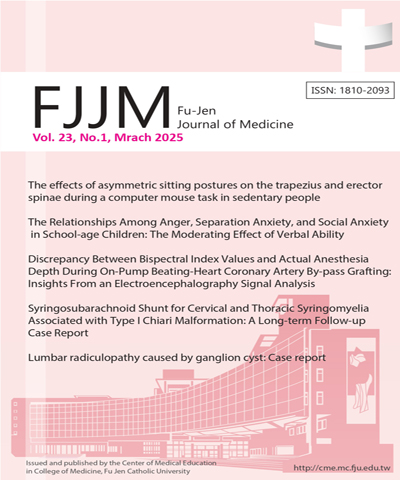
輔仁醫學期刊/Fu-Jen Journal of Medicine
輔仁大學醫學院,正常發行
選擇卷期
- 期刊
Background: The concept of enhanced recovery after surgery (ERAS) is flourishing in multiple specialties, including cardiac surgery. Beside minimally invasive surgical approach, short acting anesthetic agent is one of the major components of ERAS programs. Remifentanil is an ultrashort acting opioid agent. The purpose of this study was to compare remifentanil and low dose fentanyl for postoperative recovery profile in patients undergoing minimally invasive cardiac surgery (MICS). Methods: This study was a retrospective study. We compared the recovery profile including extubation time after surgery, length of hospital stay, postoperative morphine consumption, pain scores and in hospital complication rate between patients undergoing elective MICS from May to August 2018. Results: Fifty-three patients were enrolled in this study, 33 of them were in group remifentanil (G.remifentanil) and 20 were in group fentanyl (G.fentanyl). The extubation times, average hospital stay, postoperative morphine consumption, pain scores and in hospital complication rate were all similar between both groups. Conclusion: We consider remifentanil can be safely used in MICS and provides similar recovery profile as low dose fentanyl.
- 期刊
Background: Appropriate management of adverse medical events (AMEs) is the corner-stone of patient safety. Root cause analysis (RCA) is used to investigate serious or high-frequency errors, but is limited by its inability to explain a broader scope of factors. We re-reviewed RCA cases to understand the underlying human, organizational, or systemic factors affecting AMEs. Methods: A total of 40 consecutive RCA cases (2012-2016) were retrieved from the AMEs database. A panel was organized to retrospectively re-review these cases using the Human Factor Analysis and Classification System HFACS. Results: For active failures, errors stemmed largely from performance-based (95%), judgment and decision-making errors (87.5%). Incorrectly followed procedures (81.6%) and accidental equipment operation (50%) were the most common types of performance-based errors. In-adequate real-time assessment (68.6%) and inappropriate operative actions (68.6%) were the most common decision-making errors. For sources of latent failure, teamwork problems (27.5%), including failure to effectively communicate (81.8%), and communicate critical information (72.7%) were common. Inadequate supervision (92.9%) or command oversights (92.9%) were the most common problems related to inadequate supervision (35%). Organizational program/policy risks not adequately assessed (50%) were the most common problems related to policy and process problem (25%). Conclusions: The HFACS review enhances our understanding of human factors underlying AMEs. The HFACS reveals latent supervisory, organizational, or systematic problems that cannot be addressed through traditional RCA.
- 期刊
Lesions of the caruncle are very rare. Most caruncular lesions are benign, though there were still few reported malignant lesions. Ocular adnexal lymphoproliferative disease (OALD), one of the differential diagnosis of caruncular lesion, is seldom seen in young patient. In this article, we report a 16-year-old boy with recurrent caruncular atypical lymphoid proliferation. We discuss the epidemiology, clinical features, images, histomorphology, and treatment between ocular adnexal lymphomas (OAL) and reactive lymphoid hyperplasia (RLH).
- 期刊
Burr hole craniostomy with closed-system drainage is an effective and common neurosurgical procedure to manage chronic subdural hematoma. Postoperative hemorrhage, a well-known but infrequent complication, may result in increased neurologyical deficits. However, hyperacute intramembranous hemorrhage within the inner andouter membrane of hematoma after burr hole craniostomy with irrigation and closed-system drainage has not been described previously. Herein, we report a case of postoperative spontaneous hyperacute intramembranous hemorrhage after burr hole craniostomy with closed-system drainage to manage a chronic subdural hematoma; we subsequently discuss the possible pathophysiological mechanisms and review the relevant literature.
- 期刊
Breast hamartoma is an uncommon benign tumor rarely associated with malignancy. An excision and histological examination is necessary for the differential diagnosis. We report a case of a 49-year-old female patient presenting with a lump in the right breast. Ultrasound examination which demonstrated a 4.4*1.1 cm hypoechoic lesion with lipoma. Partial mastectomy was arranged and the diagnosis of a hamartoma was confirmed by the histological examination.

